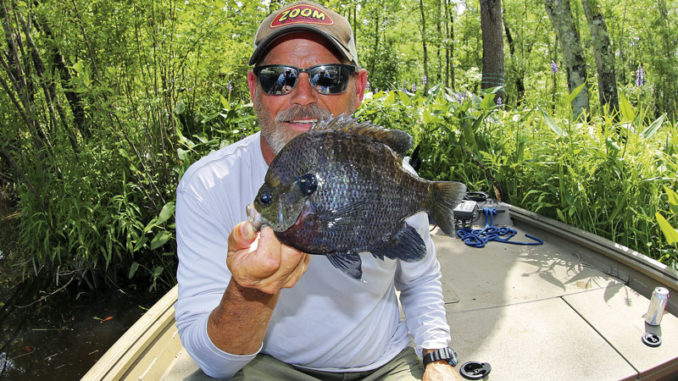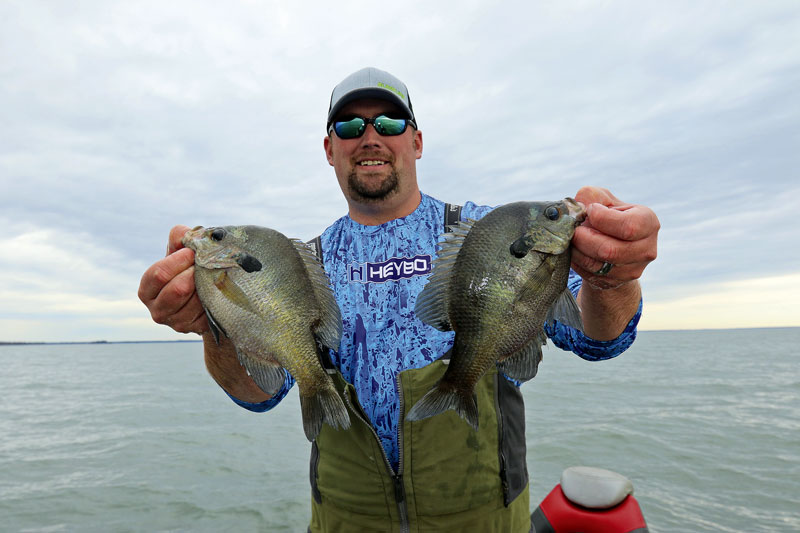
A favorite among almost every angler, these sunfish are found everywhere and revered where they’re found
Bluegills, Lepomis macrochirus, are one of the most-popular and populous fish in North America. For many anglers, they are the very first fish ever caught. They are known among fisheries experts as “laterally compressed, or flattened sunfish.”
Depending on the water color and quality where they are found, bluegills can range from almost solid black to olive in color with orange or yellow breasts. Their fins are clear, except for a distinguishing black smudge on the bottom of the rear of the dorsal fin. Along with its black earflap, that black smudge is the surest way to identify it from some other members of the sunfish family.
As the name implies, these fish often — but not always — have blue to violet coloring on their gills and throughout the top portion of their bodies. This is most evident among males that are breeding.
The bluegill is native to the eastern United States, but it exists nationwide thanks to stocking programs. They are one of the most-commonly stocked fish in ponds and lakes. They are a favorite among anglers, especially those who like to fish the old-fashioned way, with live bait under a cork.
Home? Anywhere
These fish are highly tolerant of a wide range of habitat. Small ponds, creeks, rivers, swamps, oxbow lakes, retention basins and drainage ditches are all suitable waters. They are usually found close to some type of structure, including flooded vegetation, tree stumps, downed timber, rock walls and sunken debris.
Anglers find their share of bluegills in mostly shallow water during the warm months,; few anglers fish for them during winter. Those that do often find them as deep as 60 feet in lakes.
Bluegills aren’t too picky about what they eat. Insects of all sizes, small invertebrates, crawdads, freshwater mussels, grass shrimp and tiny fish make up their diets. Their mouths are fairly small, which limits their choice of potential meals.
Live crickets are among the most-popular baits for bluegill anglers. Live red worms, night crawlers, wax worms, and catalpa worms will also draw strikes. Small crawdads are excellent baits but not widely available at bait shops. Small spinners, tiny crankbaits and artificial flies also work great.

Safety in numbers
Bluegill colonies are often made up of as many as 100 circular nests. Safety in numbers seems to be their motto, as their huge colonies help protect their eggs and fry from predator fish. They spawn throughout many months, as long as the water temperature is at least 75 degrees. In the South, this usually lasts from May through August, sometimes into September.
Prolific spawners
Females can lay up to 80,000 eggs in a year, and they often deposit them in several different nests. Males, likewise, spray their sperm in multiple nests. The bluegill is the only species of sunfish that does this. The males guard the colonies until the fry disperse.
Bluegills are often called bream, sunfish, sunny, blue sunfish, coppernose and blue perch. They are often confused with redear sunfish, aka shellcrackers, and with green sunfish and redbreast sunfish.
The Louisiana state record bluegill weighed 1.83 pounds and was caught by Timothy Delaney in Iatt Lake during May of 2016 2.24 pounds and was caught by Tim Trahan at an Arcadia farm pond on May 30, 2022. The world-record bluegill weighed 4 pounds, 12 ounces and was caught by T. Hudson in Ketona Lake, Ala., on April 9, 1950. That fish is not only the world record, but is also the oldest bluegill on record from any state.
The post Species spotlight: Bluegill first appeared on MS-Sportsman.com.











































![Air gun 101: The differences between .177 & .22 – Which jobs they do best ? [Infographic]](https://airgunmaniac.com/wp-content/uploads/2020/09/g44-150x150.jpg)